Parco Natura Viva
- Address: Località Quercia, 37012 Bussolengo, Verona
- Tags:
 What to see Verona,
Verona,
Italy
What to see Verona,
Verona,
Italy
- Telephone: +39 045 717 0
- Website: www.parconaturaviva.it
Zoo Safari in Italy? Yes, please!
I am sure you have never thought that you can have an amazing safari tour in Italy. Me neither, until I heard of a place, called Parco Natura Viva, also known as Verona Zoo Safari. I have not travelled for quite a long time this year because of my studies, but then I saw an advertisement for an organised excursion of the Zoo Safari. It lasted only for a day, which was nice for taking a break from my studies, everything was organised and the price was low, so I decided I will take this opportunity. And I was not disappointed at all. You can read more about my experience in the park below.
Where can I find this amazing park?
Verona is quite an interesting city, because it has many sights to offer. For example, here you can see the Juliet's balcony from the story of Romeo and Juliet. But I will describe that place more in detail in another entry. What I am trying to tell you, is, that Verona as a city can keep you occupied for a few days. And when you think you have seen everything there, you figure out that the surroundings of the city are at least that interesting as the city itself. For example, very close to the city, you can find several amusement parks, and the main reason for writing this entry, Parco Natura Viva.
You can find detailed instructions on how to get to the park, on the park's website. I do not think it is necessary to write them again here, because they are very simple and doing so would seem like copying. Let me just say that this place is well accessible from any direction you are coming from. For example, I am coming from a small coastal town in Slovenia, called Koper. From there, it only takes about two hours by bus to get there. The place is not hard to find if you are going by car either, because everything is well marked and there are those big jumbo signs all around Verona, inviting you to go there.
A short overview of Parco Natura Viva
In this paragraph, I will describe how our visit to the park looked like. The park is fairly big and it could be quite hard to navigate if you do not have a map with you. But do not worry, you get your map at the entrance, when showing your ticket, and there are also big signs with maps all around the park.
The park itself consists of three parts. One of them is the actual zoo safari, the other one is the ZOO, and the last one is the part with the dinosaurs. Not the real ones, of course, but I will tell you more about it a bit later. For now, let me just show you a picture of what awaits you if you keep reading:
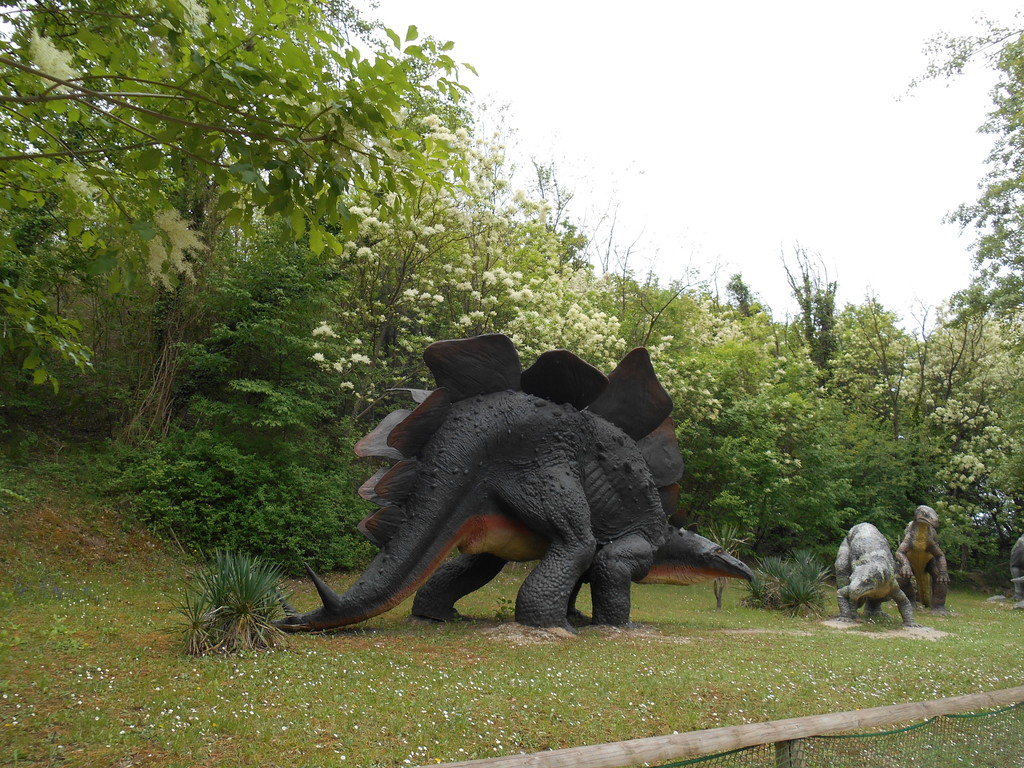
Each one of those three parts is divided into smaller units. Feel free to read a more detailed description below.
We started our visit with a zoo safari. To get a glimpse of how big the place actually is, let me tell you that we were driving through with a big bus, and it took us about fourty – five minutes of not – so – slow driving to reach the end of the safari. You are now probably wondering, how it is. If I could describe it with one word, I would say 'fascinating'. But this word is not even close to how awesome this place really is.
When I decided to go on this trip, I was a bit sceptic about all this. I mean, there is a place, close to me, where you can take a safari tour, and I have not heard of it yet? Come on, I really imagined just a few monkeys, running around.
But, as I said, I was wrong. The safari trail is circular, so you do not have to turn your car somewhere in the middle and drive all the way back, which is pretty nice. After entering the place, we passed two security gates, which prevents animals of escaping. Then, the safari started. First, we didn't see any animals. But then, we saw three rhinos, zebras and a few giraffes, very close to us. And what was even better, they came all the way to our bus.
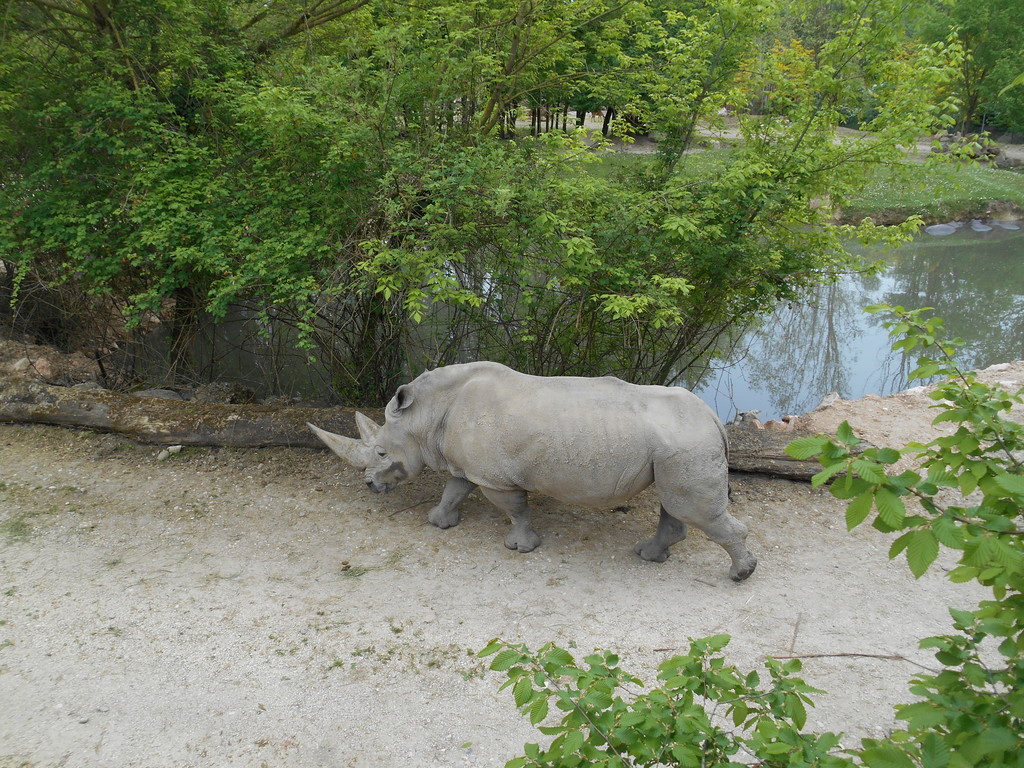
They were so close that we could even touch them if we wanted. Too bad that it is impossible to open windows on the bus. Keep in mind that touching the animals is not forbidded, but it is not advisable either. However, you are not allowed to get out of the vehicle under any circumstances. What I really liked (besides the animals, of course), was the different terrain that you have to drive through. The safari starts on a big field, and then, the road starts climbing uphill, and there is even a thick forest, where you can see some of the animals. When I was there, some of them were hidding, but honestly, we managed to see a lot of them.
There is another thing that makes this safari so special, and close to the feeling of being on a real safari – it is not a hundred percent guaranteed that you will see all the animals that live there. If they are hiding in their shelters, all you can do is come back another time and hope you will be more lucky. In fact, our tour guide told us that we were really quite lucky on that day, because, as she said, on their last visit, they did not see a lot of animals and the passengers were very disappointed. But hey, where is the fun part if you already know in advance, what exactly you will see? But, on the other hand, what is the point of paying for the entrance and not seeing any animals?
After passing through the forest, the road will turn and take you at the edge of the hill, where you can admire the place below from a different perspective. It is true that the animals are a bit far away, but you actually get to see much more from up there.
Since we went up the hill, we also had to get back down. The way down is a bit different. Before that, you are able to see the animals that live in the savanna, and now, you will be driving through some sort of a rainforest. I know that the conditions there are artifically made, because there is no way a real rainforest would grow in the middle of Italy, but it actually seems very pristine. And you get to see some really interesting animals there, particularly from south america. My favourite is definitely the tapir, which looks like half pig and half elephant with a short trunk. You are able to see tapirs from more close up again later in the zoo. Seriously, they are so cute that I would have them as pets if I could.
When you arrive to the bottom of the hill, you will again pass throgh two security gates, but the safari is not over yet. Actually, the best part is yet to come! This is indeed the last part, but here, you can see animals such as tigers, cheetahs and other big cats, which are really beautiful, and they seemingly live all together in peace.
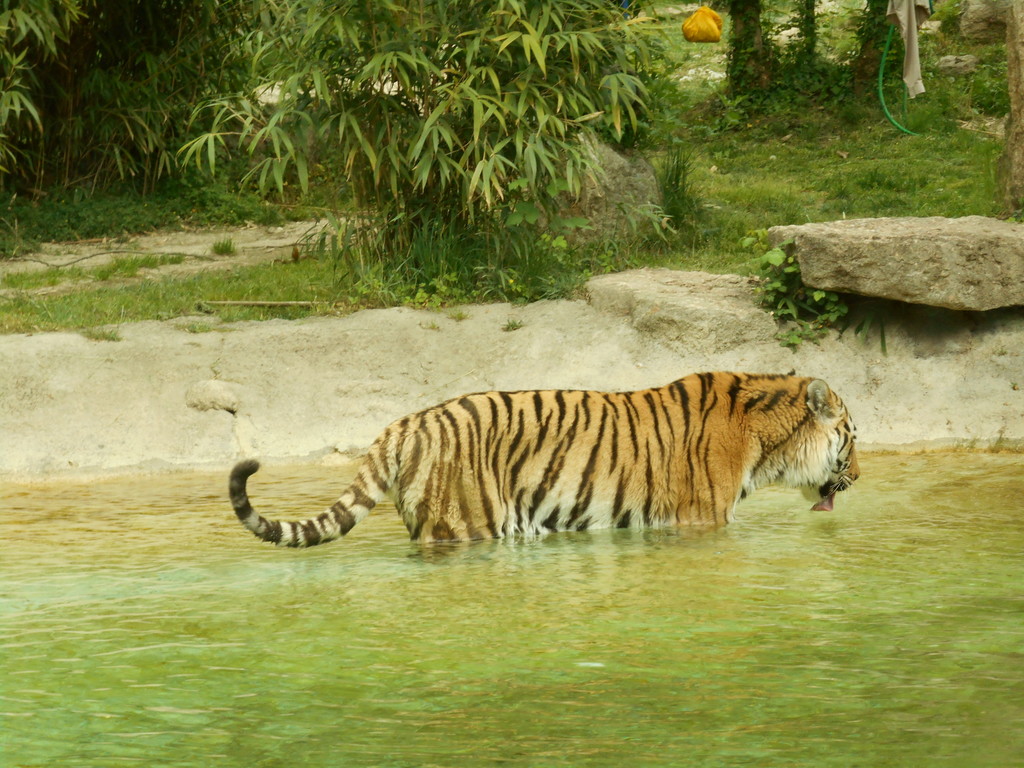
If you are lucky, you will be driving through this part during feeding times. I actually thought that they will feed the big cats with live antilopas or something similar, but then I have remembered that it would have been a bit cruel, and also not a very nice thing to see for some visitors. We were lucky enough to see the lions being fed by large pieces of meat.
The place where all the big cats live, is also very spacious, and you might be lucky enough to see them running. It seems unbelievable how fast they can run.
Soon, you will arrive to the end of the safari, and now it is time to go to the zoo. After we were finished with the safari, the bus stopped on a parking lot and we entered the zoo. On the map that you get, the place looks fairly small, but once you are inside, you realize that it is actually pretty big.
The zoo is more than informative, each animal is described in detail, and in some habitats, you can also see video presentations of the animals, living inside.
Right after the entrance, there is a meadow and a small stream (which forms a tiny lake at some point) with lots of flamingos, living there. Why am I describing this? Because I found those animals very interesting for some particular reasons, listed in addition. First of all, they make a sort of a quacking sound, and this is definitely not how I imagined a bird sound. Secondly, there were a lot of baby flamingos there, and they were grey, fat and seemed very fluffy. You can even spot some on the picture below.
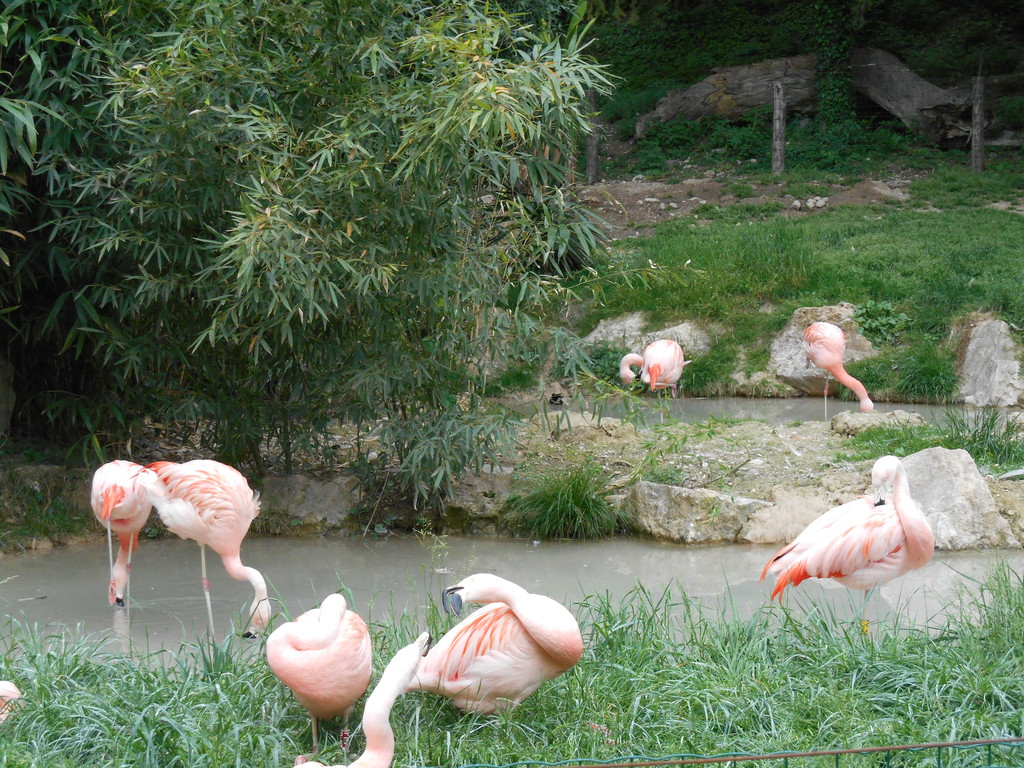
Also, I found it quite impressive that flamingos can stand on one leg for such a long time, and their legs are super tiny. Last but not least, there was an information on the sign that really caught my attention and made me smile – the flamingos get their pink colour from some food they eat – it colours their feathers. It would be pretty nice if our hair colour would also change, based on what we eat, wouldn't it?
After the flamingos' habitat, you can either choose to take the path that goes on the left or the one that goes on the right. It does not really matter which one you will choose, because you will get to see same animals, the only difference is the order of seeing them. I took the right path and therefore I will describe it below, so you can get a brief picture of how it looks like.
The whole zoo is somehow divided on different continents or countries, which means that animals that live next to each other in nature, also live close to each other in the zoo. For example, you will not see a tiger near the koala. First one of the continents presented, was Africa.
First thing that will definitely capture your attention after the flamingos, are the hippos. When I went past their habitat, all of them but one were in the water, and the one that was outside, did not seem very interested about anything that was surrounding him. Well, if you decided to go inside and pet him, the story would probably quickly change. And I heard that they can run pretty fast!
After the hippos, you will see the animal that you have already seen on the safari tour – the rhino. There were more of them in the fence than I expected – I have spotted five of them, and one was a baby.
Following the rhinos, there is a monkey habitat where you can see several monkey species. The chimpanzees were the most interesting for me, and seemingly to other people too, because there was the whole crowd in front of their place. One of the chimpanzees was trying to do something with two sticks (maybe light a fire, who knows), and the other one was teasing him, and they would keep repeating that, so I have eventually moved on to the next habitat.
The habitat that is following the Africa, is Oceania. This part is the smallest of them all, but it indeed does have some of the most interesting animal species. The cutest one was defintely the wallaby, which somehow looks like a strange kangaroo.
Next group of habitats that I have visited, was Asia. Honestly, this was definitely not a very interesting part, and the only animal that has caught my attention, was the snow leopard, which was one of the most beautiful animals I have ever seen. And it was not completely white, which I have imagined before seeing it.

After a short lunch break in one of the many snack bars, I have moved on to the habitats of America. This part consists from a lot of different, and very interesting species. Again, there was too many of the animals to list all of them, but the most interesting ones in this part were the sloth, tapir and ocelot, which looks like a domestic cat, mixed with a gepard. If I could, I would definitely take one of these home with me.
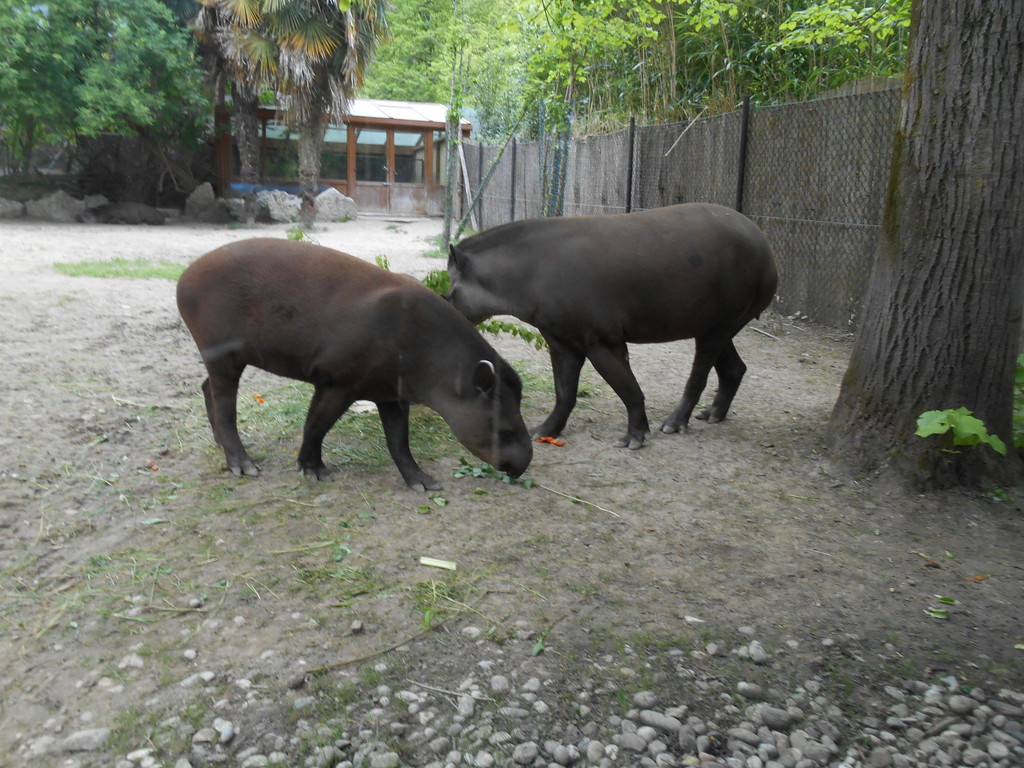
Following America, there was Australia, where you cannot see much, but a few kangaroos and koalas. Here, it was the first time ever I have heard the sound of a koala. And believe me, the sound is so weird that I immediately considered whether to stop liking koalas forever or not. It is also very loud.
The last part of the park before the prehistoric surprise at the end, is the European continent. This part was not that interesting for me, because I have seen many of those animals even in their natural habitat. But I admit that it was nice to read the informative tables, because I got to know some new, and very interesting things.
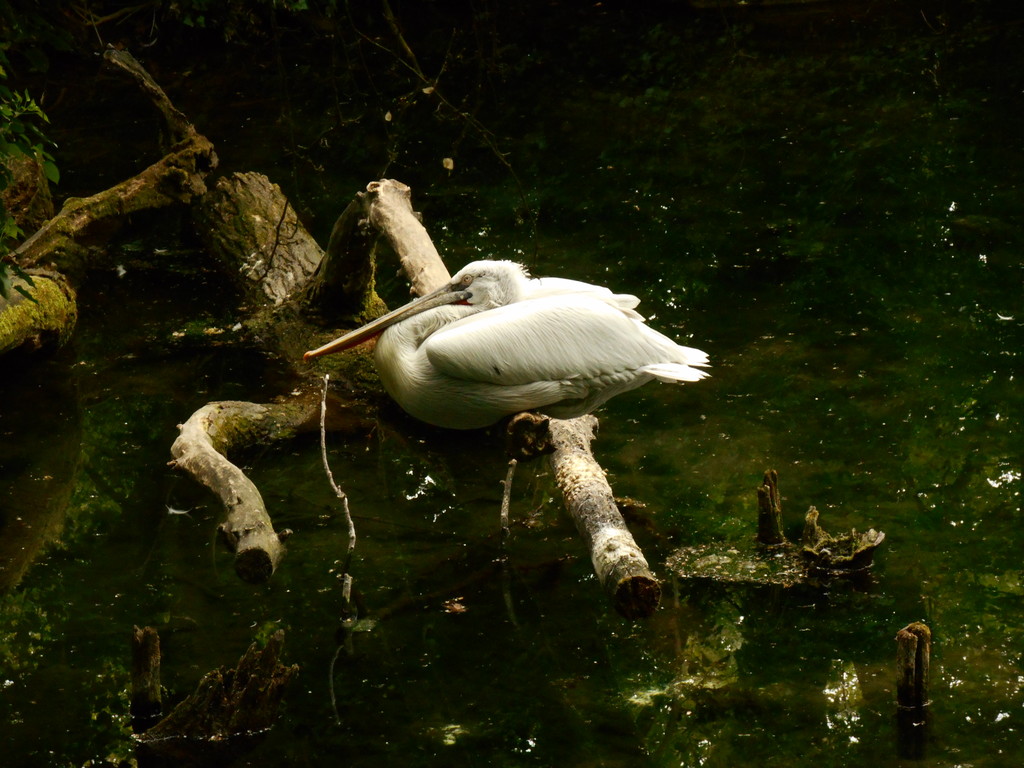
I have left the most interesting part of the Parco Natura Viva for the end, both during my visit and here in my entry. Why is it so special? Because, drum roll, you can see the dinosaur sculptures here in their natural size. Believe me, you will feel really small when walking through this habitat.

And it is amazing how detailed the sculptures are, and the background is very scenic, too. I was almost expecting that one of them will just move out of a sudden, and grab me, they really look that alive and realistic! And wait, I have not told you everything yet. You can also hear sounds of these giant animals (at least the ones the creators of the park thought the dinosaurs were making). Have I convinced you already to visit this place soon? I really hope so.
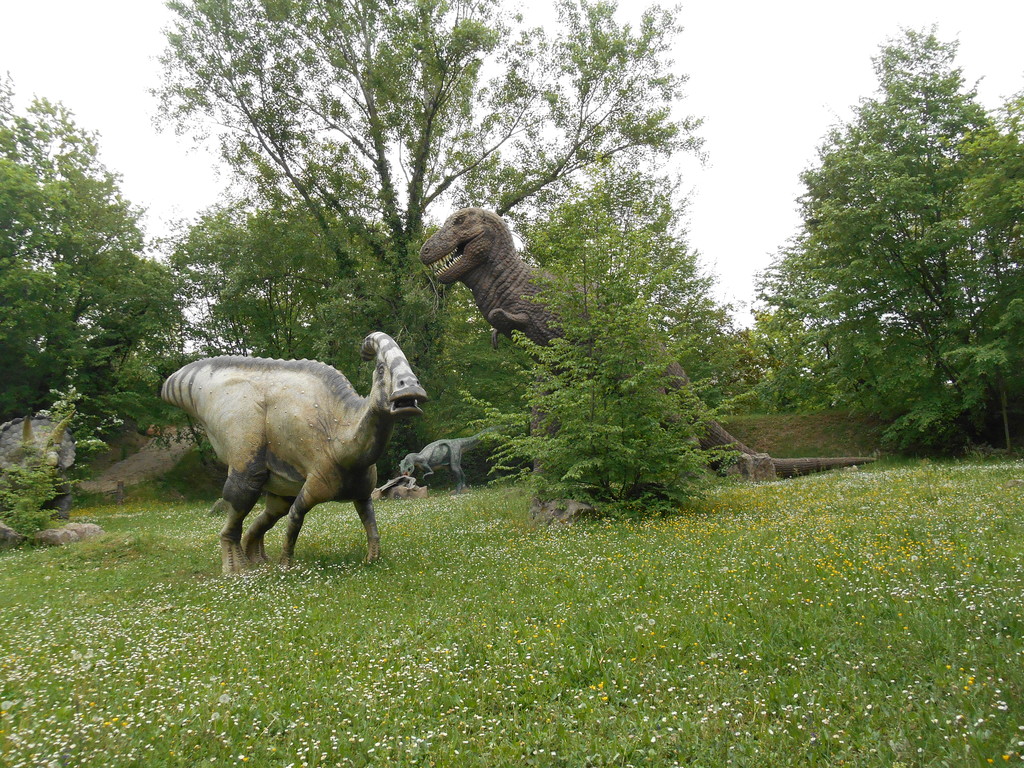
What would, in my opinion, be a nice addition (but also a very scary one), would be the animated sculptures. Nothing dramatic, just opening their jaws or moving their leg or tail. I am sure that younger visitors would definitely love it.
In this habitat, you can see seven different species of prehistoric animals, and each one is situated in what is believed to be their natural enviroment.
The animal that would make me scream and never leave the house if it was not extinct, was the giant dragonfly. Its wings must have measured at least one meter. Now imagine this beast, flying around your house!
Next one is the bird that we all know as dodo. On the sign, it said that its closest relative is the pigeon, but it looked more like a very fat turkey to me. It seemed that a lot of people are interested in dodos, because I almost had to wait in line to take a photo of it.
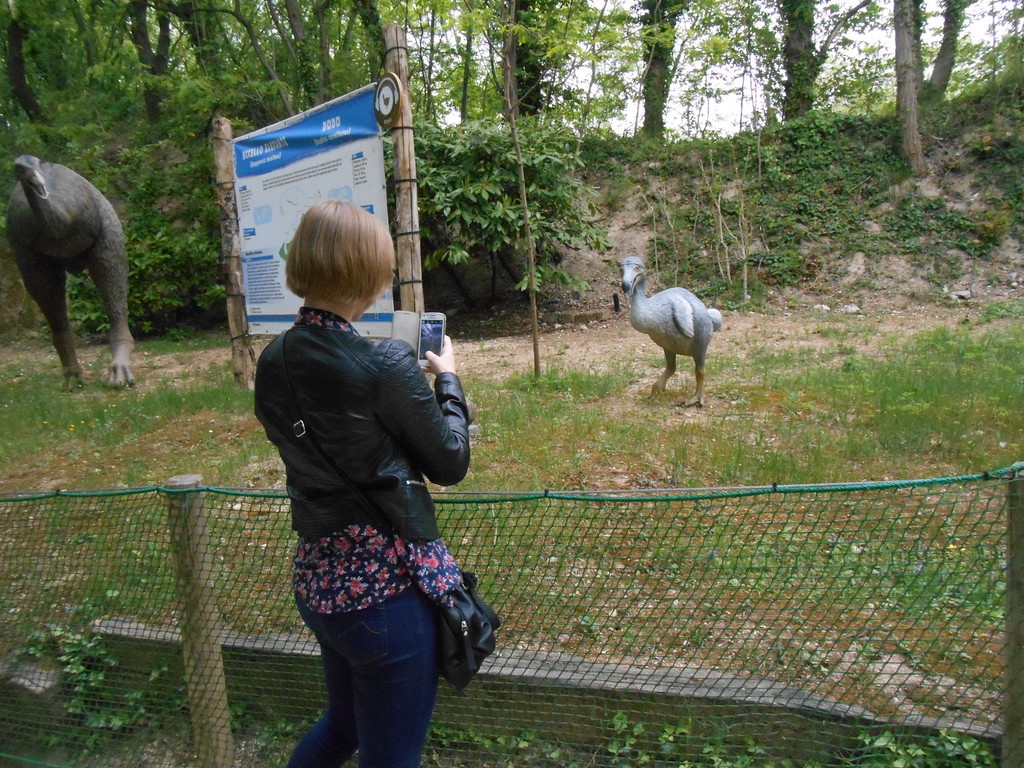
Another interesting preistoric bird was the ornitocher. Well, with its size, it could be easily called a plane, not a bird.
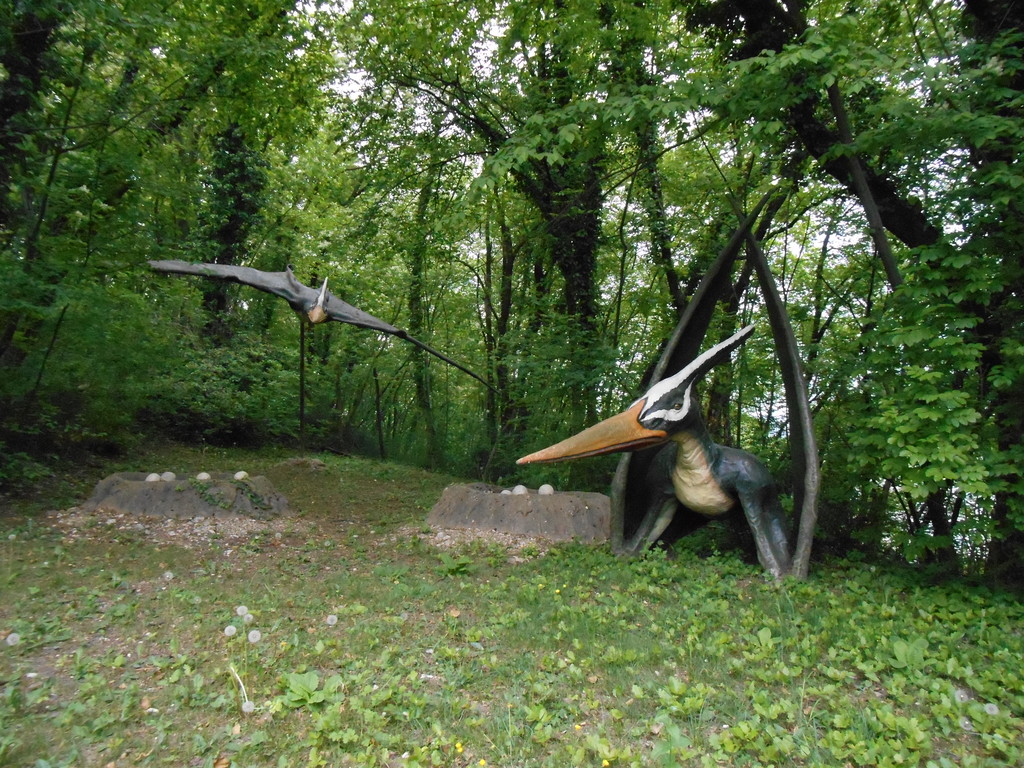
Following the ornitocher, were the dinosaur species that we all know, if not from anywhere else, from different movies and cartoons, such as raptors, stegosaurus, and even a T-rex! As you can see, I took some photos, so you can see a glimpse of a prehistoric world for yourself.

Next to the prehistoric habitat, you will find a reptille house, where smaller relatives from what you just saw, are living. Here, I have seen plenty of species I have not even heard of before. What I found funny, were the signs on each one of the habitats. They were showing the 'resident' of the place, saying: do not knock on the cage, I will not open.
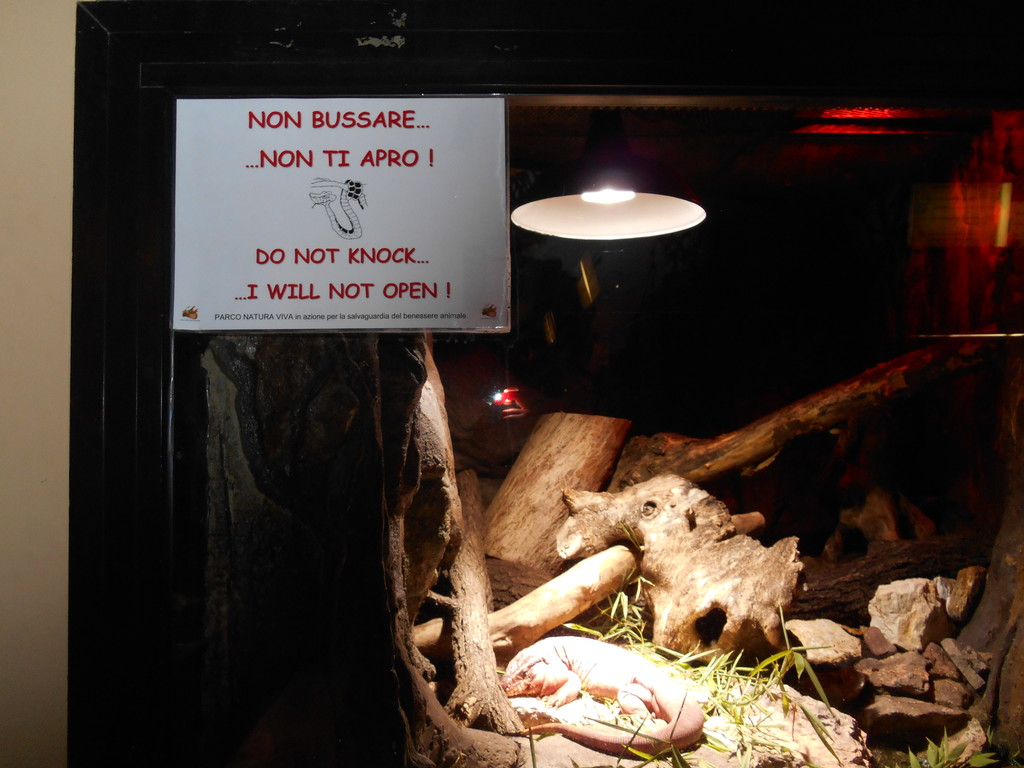
By the way, the zoo is very big, so I have not described all the animals, just the ones that were the most interesting for me. If you decide to go there yourself, make sure that you will have enough time to see everything that you would like to see.
There were two places that have especially caught my attention inside the zoo. First one was the butterfly house. I did not even know what this place is, until I was already inside. I have to admit that I have a fear of butterflies, and I have no idea where it came from. So when I saw the sign that the butterflies are flying around freely, I quickly ran out, so I cannot tell you anything about that place. But other people from my bus went inside and they told me it was quite fun, because the butterflies were even landing on them. Well, all I could say when I heard that, was: 'Eeew, flying spiders! No, thanks. '
Just before the exit of the zoo, there is a small petting zoo. I think that the petting zoos are now a must – have for every zoo that wants to be 'trendy'. But the petting zoo in Parco Natura Viva really is something special. Unlike in other petting zoos I have seen, here, there is one of the staff members, designated for every animal that is inside, and he or she will take the kid to the animal. I think this is both nicer and much safer for everyone.
Food and drinks
Good news is that you do not even have to bring your own food to this zoo. There are several food and drink shacks all along, the prices are very low and the food is healthy. Oh, and a huge bonus for Italy, staff members speak English and some other languages, too!
Each one of the food shacks is themed differently – it depends on where in the park it is situated. Also, all the meals have quite interesting names. But I would not like to spoil you all the joy. When you will visit this place, you will see what I am talking about.
As I have mentioned above, the prices are low. For example, a big sandwich will cost you two Euros and a half (and it is freshly made, also, you can choose what ingredients would you like to have inside), and a daily menu five Euros. The portions that you get when choosing the daily menu, are big enough for two people.
Opening times
It is more than awesome that Parco Natura Viva is opened throughout the year. Of course, if the weather condiions are bad, the park will be closed, and also, if there are some renovations coming up, it is not possible to enter.
If you would like to make sure about whether the park will be open or not on your intended day of visit, you can check it at their website or call their information line, they will gladly help you.
So, what are the opening times? The park opens at 10 am and it closes at 5 pm, but keep in mind that the last possible time for entering is 3 pm, so you still have enough time to get through all the habitats, although you might have to hurry up a bit.
Prices
You have different options on purchasing your tickets, and the prices also vary, based on your choice. You can find more detailed information on the park's website, but here, I will just give an example of a few ticket prices and options, so you can get the feeling about how (in)expensive your potential visit at Parco Natura Viva would be.
Small children have free entry (I think that they have to be under three years old to be elgible for that), kids will pay fifteen Euros and adults will pay twenty Euros. You can also take an advantage on different special offers that are regularly published on the park website, you just have to keep an eye on it.
But the cheapest option is definitely if you travel with a group. For example, when I went there, there was a group of about thirty people in our bus, and the ticket price was reduced to seven Euros, which is really cheap.
On (very rare) occassions, it is also possible to visit the park at night time, and the ticket for that adventure costs (only) ten Euros. Would you dare to do it?
How much time should you take for your visit?
It really depends on how much time will you spend at each habitat, because some animals might seem more interesting to me than to you. But, including the safari and a quick meal, I would say that four hours are more than enough for a relaxing stroll through everything you might want to see.
For the end…
Parco Natura Viva Verona is a great place to spend the day at, and at the same time, also learn something new. Everything is well marked, and there are also always some staff members walking around, so in case you have any questions, you can ask them and they will gladly answer to any questions you may have, regarding either the directions or information about a certain animal.
What I liked the most about this place is not the low price, its accessibility, or the amount of animals inside. No, it is how they treat animals. We have all probably been in at least one zoo, where animals are trapped in small cages, almost unable to move. But not in this place. I know this is still a zoo and animals live there in captivity, but the habitats of the animals are really big. Even the place, where the birds are, is unbelievably enormous. The birds that live there, actually have plenty of space to fly around.
Photo gallery
Content available in other languages
- Español: ¿Zoo Safari en Italia? ¡Sí, por favor!
- Italiano: Zoo safari in Italia? Sì!
Rate and comment about this place!
Do you know Parco Natura Viva? Share your opinion about this place.





























